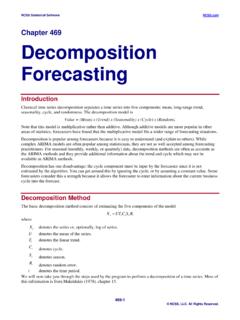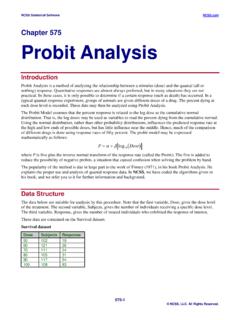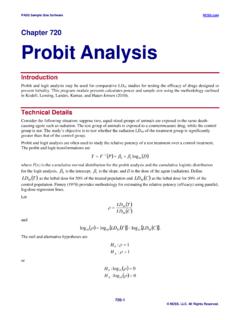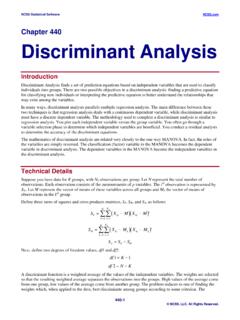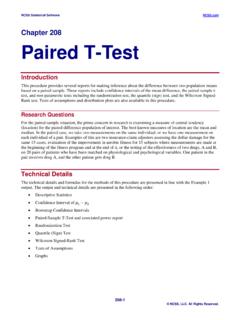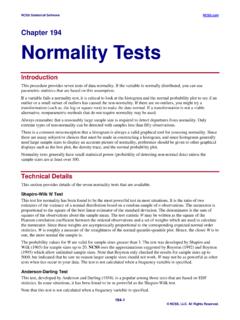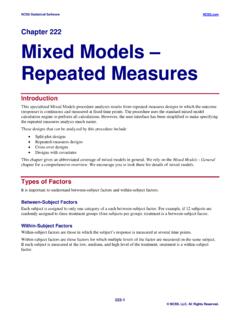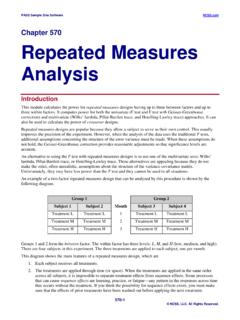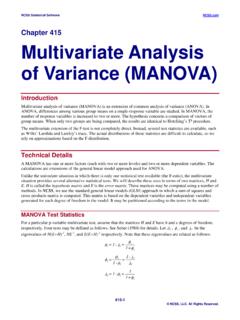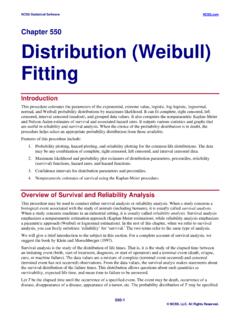Transcription of Chapter 311 Stepwise Regression - NCSS
1 NCSS Statistical Software 311-1 NCSS, LLC. All Rights Reserved. Chapter 311 Stepwise Regression Introduction Often, theory and experience give only general direction as to which of a pool of candidate variables (including transformed variables) should be included in the Regression model. The actual set of predictor variables used in the final Regression model must be determined by analysis of the data. Determining this subset is called the variable selection problem. Finding this subset of regressor (independent) variables involves two opposing objectives. First, we want the Regression model to be as complete and realistic as possible. We want every regressor that is even remotely related to the dependent variable to be included.
2 Second, we want to include as few variables as possible because each irrelevant regressor decreases the precision of the estimated coefficients and predicted values. Also, the presence of extra variables increases the complexity of data collection and model maintenance. The goal of variable selection becomes one of parsimony: achieve a balance between simplicity (as few regressors as possible) and fit (as many regressors as needed). There are many different strategies for selecting variables for a Regression model. If there are no more than fifteen candidate variables, the All Possible Regressions procedure (discussed in the next Chapter ) should be used since it will always give as good or better models than the stepping procedures available in this procedure.
3 On the other hand, when there are more than fifteen candidate variables, the four search procedures contained in this procedure may be of use. These search procedures will often find very different models. Outliers and collinearity can cause this. If there is very little correlation among the candidate variables and no outlier problems, the four procedures should find the same model. We will now briefly discuss each of these procedures. Variable Selection Procedures Forward (Step-Up) Selection This method is often used to provide an initial screening of the candidate variables when a large group of variables exists. For example, suppose you have fifty to one hundred variables to choose from, way outside the realm of the all-possible regressions procedure.
4 A reasonable approach would be to use this forward selection procedure to obtain the best ten to fifteen variables and then apply the all-possible algorithm to the variables in this subset. This procedure is also a good choice when multicollinearity is a problem. The forward selection method is simple to define. You begin with no candidate variables in the model. Select the variable that has the highest R-Squared. At each step, select the candidate variable that increases R-Squared the most. Stop adding variables when none of the remaining variables are significant. Note that once a variable enters the model, it cannot be deleted. NCSS Statistical Software Stepwise Regression 311-2 NCSS, LLC.
5 All Rights Reserved. Backward (Step-Down) Selection This method is less popular because it begins with a model in which all candidate variables have been included. However, because it works its way down instead of up, you are always retaining a large value of R-Squared. The problem is that the models selected by this procedure may include variables that are not really necessary. The user sets the significance level at which variables can enter the model. The backward selection model starts with all candidate variables in the model. At each step, the variable that is the least significant is removed. This process continues until no nonsignificant variables remain. The user sets the significance level at which variables can be removed from the model.
6 Stepwise Selection Stepwise Regression is a combination of the forward and backward selection techniques. It was very popular at one time, but the Multivariate Variable Selection procedure described in a later Chapter will always do at least as well and usually better. Stepwise Regression is a modification of the forward selection so that after each step in which a variable was added, all candidate variables in the model are checked to see if their significance has been reduced below the specified tolerance level. If a nonsignificant variable is found, it is removed from the model. Stepwise Regression requires two significance levels: one for adding variables and one for removing variables.
7 The cutoff probability for adding variables should be less than the cutoff probability for removing variables so that the procedure does not get into an infinite loop. Min MSE This procedure is similar to the Stepwise Selection search procedure. However, instead of using probabilities to add and remove, you specify a minimum change in the root mean square error. At each step, the variable whose status change (in or out of the model) will decrease the mean square error the most is selected and its status is reversed. If it is currently in the model, it is removed. If it is not in the model, it is added. This process continues until no variable can be found that will cause a change larger than the user-specified minimum change amount.
8 Assumptions and Limitations The same assumptions and qualifications apply here as applied to multiple Regression . Note that outliers can have a large impact on these stepping procedures, so you must make some attempt to remove outliers from consideration before applying these methods to your data. The greatest limitation with these procedures is one of sample size. A good rule of thumb is that you have at least five observations for each variable in the candidate pool. If you have 50 variables, you should have 250 observations. With less data per variable, these search procedures may fit the randomness that is inherent in most datasets and spurious models will be obtained.
9 This point is critical. To see what can happen when sample sizes are too small, generate a set of random numbers for 20 variables with 30 observations. Run any of these procedures and see what a magnificent value of R-Squared is obtained, even though its theoretical value is zero! NCSS Statistical Software Stepwise Regression 311-3 NCSS, LLC. All Rights Reserved. Using This Procedure This procedure performs one portion of a Regression analysis: it obtains a set of independent variables from a pool of candidate variables. Once the subset of variables is obtained, you should proceed to the Multiple Regression procedure to estimate the Regression coefficients, study the residuals, and so on.
10 Data Structure An example of data appropriate for this procedure is shown in the table below. This data is from a study of the relationships of several variables with a person s IQ. Fifteen people were studied. Each person s IQ was recorded along with scores on five different personality tests. The data are contained in the IQ dataset. We suggest that you open this database now so that you can follow along with the example. IQ dataset Test1 Test2 Test3 Test4 Test5 IQ 83 34 65 63 64 106 73 19 73 48 82 92 54 81 82 65 73 102 96 72 91 88 94 121 84 53 72 68 82 102 86 72 63 79 57 105 76 62 64 69 64 97 54 49 43 52 84 92 37 43 92 39 72 94 42 54 96 48 83 112 71 63 52 69 42 130 63 74 74 71 91 115 69 81 82 75 54 98 81 89 64 85 62 96 50 75 72 64 45 103 Missing Values Rows with missing values in the active variables are ignored.
